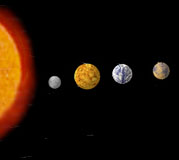Q&A: Chandra Mission
Q:
Could Chandra determine if there are planets around the closest
(or not closest) stars? Could the heavy objects be detected
around the stars, if the resolution allows, by showing an
asymmetric mass distribution around that star? Could the planets
surrounding a star be detected if they overlap an X-ray
background (coming from other objects) so they could be seen as
pieces of matter obstructing the X-ray source?
A:
It is not very likely that Chandra could determine if there are
planets around the closest (or not closest) stars. Optical
astronomers detect planets by carefully observing the spectrum
(distribution of light with energy) of a star. If a particular
feature moves around in a regular pattern, that information can
be used to deduce the motion of the star, which in turn can be
used to deduce the presence of an unseen planetary or brown
dwarf companion. The X-ray emission from stars is highly
variable, so it would be extremely difficult to deduce motion
from changes in the spectra.
Such an effect of showing an asymmetric mass distribution around
the star would be very small. The only hope would be to use
variations in the spectrum, as discussed above.
Overlap obstruction would also have a very small effect. For a
Jupiter sized source around the nearest star, any obstructing
effect would be a thousand times smaller than Chandra could
detect.
Resources
Outside the Site
Multimedia, Etc
Images/Illustrations
Animation & Video
Special Features
Chandra Podcasts
Desktop Images
The Big Chandra Picture
Presentations
Handouts
Screen Savers
Audio
Animation & Video
Special Features
Chandra Podcasts
Desktop Images
The Big Chandra Picture
Presentations
Handouts
Screen Savers
Audio
Web Shortcuts



